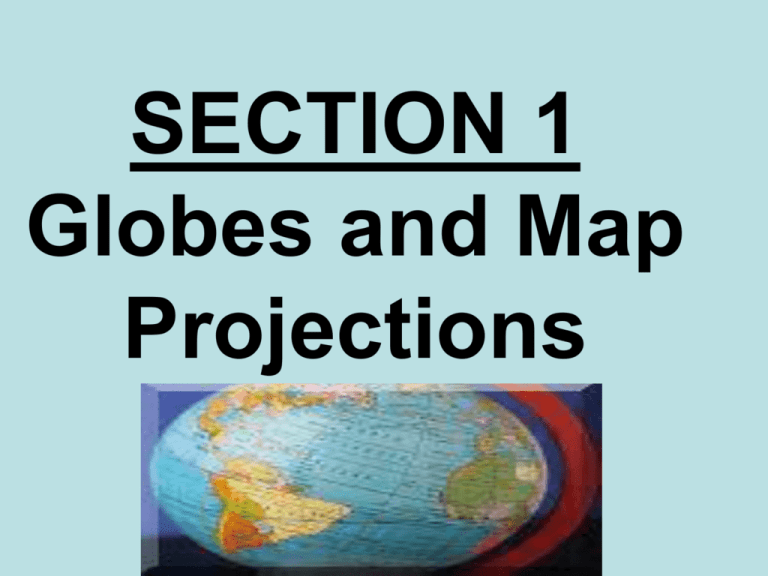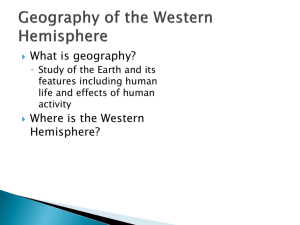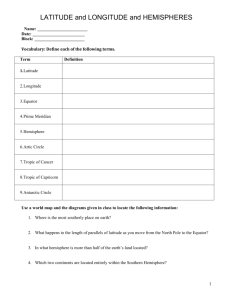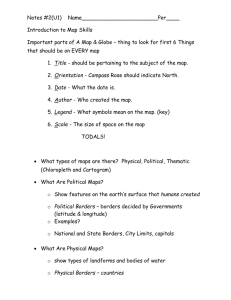chapter 1-2-3 power point
advertisement

SECTION 1 Globes and Map Projections A) Hemispheres • North of Equator=Northern Hemisphere. • South of Equator= Southern Hemisphere. • Prime Meridian is at 0 degrees longitude. • Equator is at 0 degrees latitude. B) Latitude and Longitude • Degrees North or South of the equator is called latitude. • Tropic of Cancer is at 23 ½ degrees North of the Equator. • Tropic of Capricorn is at 23 ½ degrees South of the Equator. • Degrees measured East or West of the equator is called longitude. • What is the purpose for latitude and longitude? • To find the exact location of a city or place. • Absolute location- pinpoints the precise spot of where one line of latitude crosses one line of longitude. • EX: Florence, KY 38 degrees N 85 degrees W C)Globes and Maps • The globe is the most accurate way to represent the Earth. • Mapmakers use projections to make a map. • 3 types of map projections 1) Goode’s Interrupted Projection- Adv: accurately presents the size and shape of continents. Disadv: distance in oceans less accurate. 2) Mercator Projection Adv: land shapes fairly accurately, shows true directions Disadv: size and distance not close 3) Robinson Projection • Adv: shows size and shapes of oceans and continents accurately. • Disadv: near north and south poles not accurate. Chapter 1 Section 1 Using Geography Themes A) Five Geographic Themes 1) Location- Knowing where you are -Relative location is finding out how far and in what direction you are from another place. 2) Place- Where a place is and what a place is like. - Physical Characteristics (land shape, plants, climate, animals) Five Geographic Themes Con’t - Characteristics of people, things they have created, language, clothing, music, ways they live. • 3) Human/Environment InteractionWay earth appears after humans have changed it. • (Ex) Build roads, cut down forests, build houses. Five Geographic Themes Con’t • 4) Movement- How people in one place make contact with another place. • Trading goods with other countries. • (Ex) telephone, computer, satellite • 5) Region- Areas that share common characteristics • (Ex) landscape, climate, language, Chapter 1 Section 2 A) Planet Earth • 8 or 9 planets in our solar system including Earth. • The sun is 93 million miles from the Earth. • The sun is made up of hot gases. • The Earth makes one revolution around the sun in 365 1/4 days. B) Seasons • The Earth is tilted on axis which is why we have seasons. • June 21 is summer solstice (most hours of sunlight) • December 22 is winter solstice (least hours of sunlight) • Sept 23/March 21 is spring and fall equinoxes (12 hours of sunlight & 12 hours of darkness) A) Earth’s Water • Water covers 70% of Earth’s surface. • Climate determines the amount of water a place receives. • Water, climate, and vegetation influence how people live. B) The Water Cycle • Song #1 “Water Cycle Jump” • Rivers, lakes, and oceans contain water in liquid form. • Atmosphere holds water vapor. • Water cycle is constantly moving. • The sun drives the water cycle. • Song #2 “Water Cycle Song • Draw the water cycle! (Open Response Question) C) Types of Water • Water is home to millions of kinds of plants and animals. • Song #3 “The Water Cycle Song” • Water at the Earth’s surface can be freshwater or saltwater. • Which water is most important to humans? 1) Freshwater • Only 2-3% of the water on Earth is freshwater. • 80% of that is frozen in glaciers and ice sheets. • Lakes and rivers are sources of freshwater. • Regions with little rainfall use aquifer’s for water supply. 2) Ocean Water • All oceans are salt water. • 4 major oceans (Pacific, Atlantic, Indian, Arctic) • 97-98% of the planet’s water is salt water. • The Pacific Ocean is the largest and deepest ocean in the world. Chapter 2 Section 2 Influences on Climate What causes climate? • The original source of climate is the sun. A) Latitude and Climate • Real hot and dry between the Tropic of Cancer and Tropic of Capricorn. • Cool or cold at the N/S poles. • The Earth’s tilt and rotation causes regions to receive different amounts of sunlight and seasons. • The sun’s direct rays fall yearround at low latitudes near the B) Storms • Moving wind and water make climates milder, but also cause storms. • Hurricanes form over warm Atlantic Ocean in the summer and fall. • Hurricanes bring high winds and tons of rain. • Hurricanes that form in the Pacific Ocean are called typhoons. C) Wind, Water, Currents - Latitude, movement of air, and water help create Earth’s climate. - Near equator, air and water are most intensely heated. - Large warm water ocean current is the Gulf Stream. - Gulf Stream current flows from Gulf of Mexico and the east coast of U.S. D) Hurricanes • What states could be in danger of getting hit by a hurricane? Chapter 3 Section 1 Culture A) Culture • Culture is a way of life of a group of people who share same beliefs and customs. • Culture includes: social groups, religion, gov’t, language, daily life, history, arts, music, literature, ways they make a living. 1) Early Cultures • 4 cultures arose in Asia and Africa 4-5,000 years ago. • All four cultures developed agriculture and ways of irrigating, or bringing water to the land. B) World Culture Regions • There are 5 major things that make up Culture. • 1) Governments- Authoritarian (1 person rules with unlimited power) or Democracy (Citizens choose their leaders, checks & balances) • 2) Language- Sharing languages is very important for culture. • 3) Religion- Major ones are Buddhism, Christianity, Hinduism, Islam, and Judaism. • 4) Social Groups- Many types of social groups, the amount of money normally determines your social group. • 5) Economies- How people produce goods, what goods they produce, and how they are bought and sold. Chapter 3 Section 2 Population Population Growth • Population increasing at a rapid rate over the last 200 years. • Why? 1) Better health care and living conditions have decreased the death rate. 2) High birthrate • Challenge from increased population growth is famine. • Famine is lack of food in an area. A) Population Distribution • People live on only about 15% of the world’s land. • People can’t make home, grow crops on land covered with ice, deserts, and high mountains. • Population distributed very unevenly over the Earth’s surface. • Largest population 1) Asia- 3.6 billion 2) Africa- 770 million 3) Europe- 730 million Know these Vocab Words • • • • • • Population DensityRefugeeUrbanizationDeveloping CountryBirthrateThese vocab words are on your test this Friday. Make sure you know their definitions. B) Population Growth • The world’s population is about ______ billion people. • Population has grown rapidly since the 1800’s. • 3 things determine where people live. • 1) Climate 2) Culture 3) Jobs








